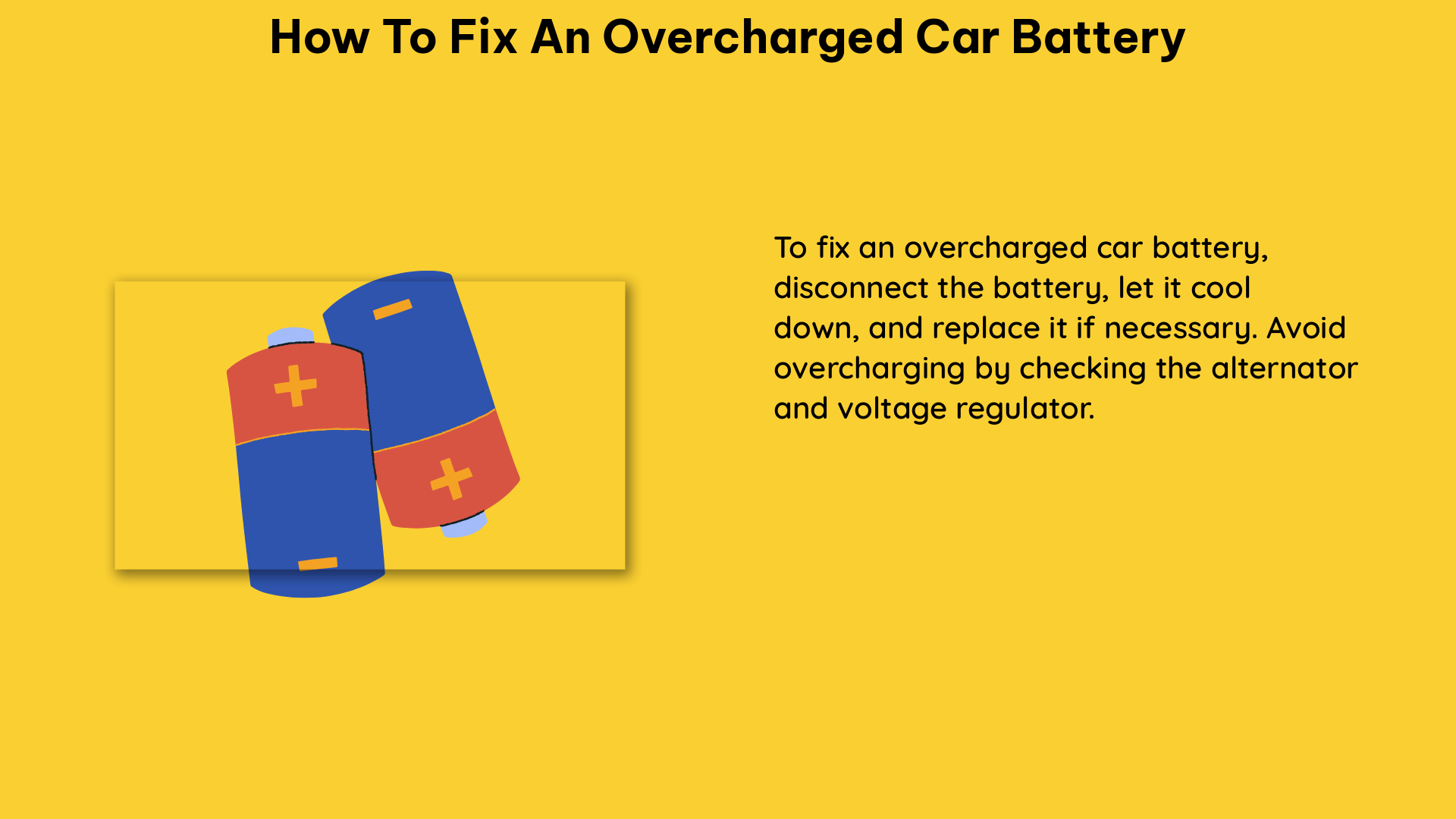An overcharged car battery can be a serious issue, leading to reduced battery life, increased risk of explosion, and even damage to the vehicle’s electrical system. As an expert on the topic, I’ve put together this comprehensive guide to help you understand the causes, symptoms, and step-by-step solutions for fixing an overcharged car battery.
Identifying an Overcharged Car Battery
The first step in fixing an overcharged car battery is to determine if the battery is indeed overcharged. A fully charged battery should measure around 12.6 volts at 80 degrees Fahrenheit (26.7 degrees Celsius). With the engine idling and all accessories turned off, the system voltage should be in the range of 13.5 to 14.5 volts.
If the system voltage goes above 14.5 volts when the engine speed is increased to 2500 rpm, it indicates an issue with the voltage regulator. This could be the root cause of the overcharging problem.
Discharging the Overcharged Battery

If the battery is confirmed to be overcharged, you can try to discharge it by turning on various electrical components in the vehicle, such as:
- Radio
- Heated seats
- Rear defrost
- Cabin lights
- Bright lights
- Stereo
Monitor the battery voltage every 5-10 minutes to ensure it doesn’t drop too low, which could potentially damage the battery. Aim to discharge the battery until the voltage drops to the 13.5-14.5 volt range.
Replacing the Voltage Regulator
If the voltage regulator is found to be defective, it will need to be replaced. This is a crucial step in fixing the overcharging issue, as a faulty voltage regulator is often the root cause of the problem.
When replacing the voltage regulator, be sure to use a high-quality, OEM-approved part. Inferior or aftermarket regulators may not provide the necessary voltage regulation, leading to further overcharging issues down the line.
Reversing Sulfation Caused by Overcharging
Overcharging can lead to a condition called reversible sulfation, where lead sulfate crystals form on the battery plates. This can reduce the battery’s capacity and performance. To address this issue, you can try the following:
- Apply an overcharge to the already fully charged battery using a regulated current of approximately 200 milliamperes (mA).
- Allow the battery terminal voltage to rise to between 2.50 and 2.66 volts per cell (15 to 16 volts on a 12-volt monobloc battery) for around 24 hours.
- Increase the battery temperature to 50-60°C (122-140°F) during the corrective service to help dissolve the lead sulfate crystals.
This process can help reverse the effects of reversible sulfation and restore the battery’s capacity.
Preventive Measures
To prevent future overcharging issues, it’s important to regularly monitor your vehicle’s charging system and battery health. Consider the following preventive measures:
- Periodic Battery Testing: Have your battery tested at least once a year to ensure it’s in good condition and not showing signs of overcharging or other issues.
- Voltage Regulator Inspection: Inspect the voltage regulator periodically and replace it if it’s found to be malfunctioning.
- Alternator Maintenance: Keep your alternator in good working condition by having it inspected and serviced as recommended by the manufacturer.
- Electrical Load Management: Avoid excessive use of electrical accessories, especially when the engine is idling, to prevent overloading the charging system.
- Battery Replacement: Replace your car battery when it reaches the end of its lifespan to avoid issues like overcharging or sulfation.
By following these steps, you can effectively fix an overcharged car battery and take proactive measures to prevent future occurrences.
Conclusion
Overcharging a car battery can lead to serious consequences, but with the right knowledge and approach, you can successfully diagnose and resolve the issue. Remember to always prioritize safety when working with car batteries, and consider seeking professional assistance if you’re unsure about any step in the process.
References
- Can I Test and Fix an Overcharged Battery?
- Battery Getting Overcharged When Charging
- Overcharged Lead-Acid Battery: What to Do?
- Sulfation and How to Prevent It
- Overcharging and Its Impact on Battery Life and Vehicle Efficiency

The lambdageeks.com Core SME Team is a group of experienced subject matter experts from diverse scientific and technical fields including Physics, Chemistry, Technology,Electronics & Electrical Engineering, Automotive, Mechanical Engineering. Our team collaborates to create high-quality, well-researched articles on a wide range of science and technology topics for the lambdageeks.com website.
All Our Senior SME are having more than 7 Years of experience in the respective fields . They are either Working Industry Professionals or assocaited With different Universities. Refer Our Authors Page to get to know About our Core SMEs.